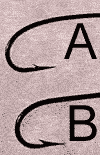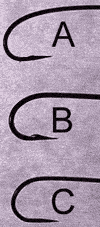 |
|
To
prepare your tackle: The season has just closed, and before you put
your rods, reels for the winter, a little cleaning and inspection are necessary:
-Wash the rod with a sponge and soapy water, around the rings and reel
seat, use a toothbrush. Check
all the rings to detect wear or a deterioration of the wraps. Repair
with epoxy or varnish if need be. If rings are damaged you can repair
them or entrust the rod to a professional.
- Clean the cork handle with a rag soaked with cellulose thinner. The holes
and cracks can be repaired with wood paste : choose the adapted color,
fill the holes with the paste,
let it harden and smooth with a very fine sandpaper.
- the metal parts of the reel-seat can receive a light layer of lubricant ( protect the
cork).
- lines must be removed from the reel, washed with soapy water,
rinsed and reconditioned.
- For the reels, dismantle them for inspection,remove any sign of rust,
lubricate
all the metal parts, lubricate the mechanism.
- For nylons, eliminate the worn parts, if you want to preserve them for season 2001
put the bobbins safe from the light.
- The used flies can be cleaned with steam (seize them with a tweezer),eliminate
those which are too much damaged.
- Inspect your waders and make the repairs
also check the landing net and repair the broken meshs.
This work, a little tiresome, will make for a good start at the beginning of the
2006 fishing season
|
Barbless
hooks : Crush barb or barbless hooks are obligatory on
all the No-kill, rivers,
lakes or reservoirs. - the absence of barb makes it possible to easily
release fish and won’t
tear the flesh.
– At right, A, Tiemco n°12 and B, Mustad n°12, note the difference
in the size of the barb.
- Below the same 2 hooks A and B with the barb
crushed , A is sharp, with B, the barb is
flattened, but a bump remains. C, is a barbless hook, there too
the point is sharp.
- Is it necessary to crush the barb apart from No-kill? I always do it
before tying the
fly, not after, because sometimes the hook breaks.
- If the tension is maintained
one does not lose more fish, the undersized trouts are very
easily released, and if the hook
catches in the net or to a sleeve, it is removed with ease.
- Should
it be done with a treble
hook lures? To remove a treble hook from a net is difficult, without
barb, it is not a problem.
- To
crush the barb, use a small plier with flat jaws, then tighten gently |
 |
 |
|
Dry flies fishing
Fly float: Instead of using spray or liquid
fly float, use green or red mucilin or gel and apply it to the fly
with a small, soft paintbrush ( the ones used by children for
waterbased paint). With this tool, you can dab the hackles, the
body and tail without getting greasy fingers. You can even
use this method on CDC flies, stroke gently the fibers with the
brush, it leaves a minute amount of floatant which greatly improve
the fly floating durability .
Drying the fly: After
catching a fish, the fly needs to be cleaned and dried. To dry it,
in place of the amadou patch, use a feminine sanitary pad ( thin
one), by design, they have excellent absorbency and the right
size. To dry the fly , place it on the surface, fold the
pad, wait a few second, it's done.
Degreasing the leader: To sink the tippet is a must
for dry flies fishing, to do it, use kitchen cleaning powder
(ajax....) on your fingers. At the same time, as it is slightly
abrasive, it removes the shine from the nylon. |
|


